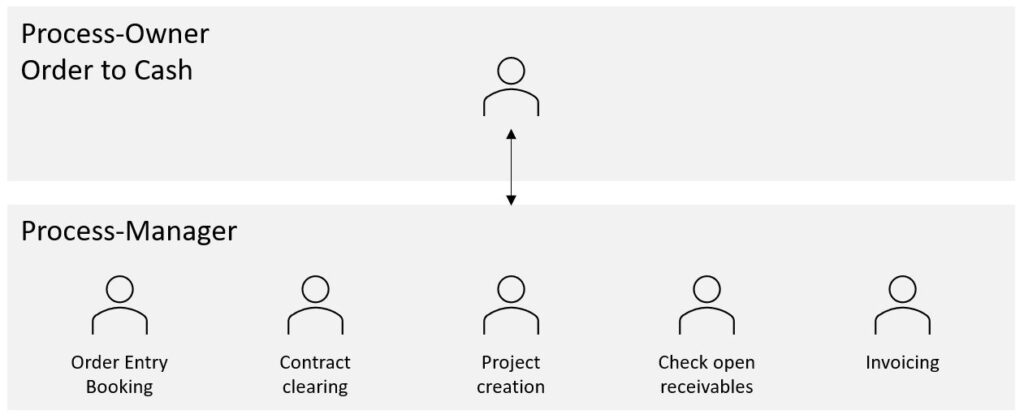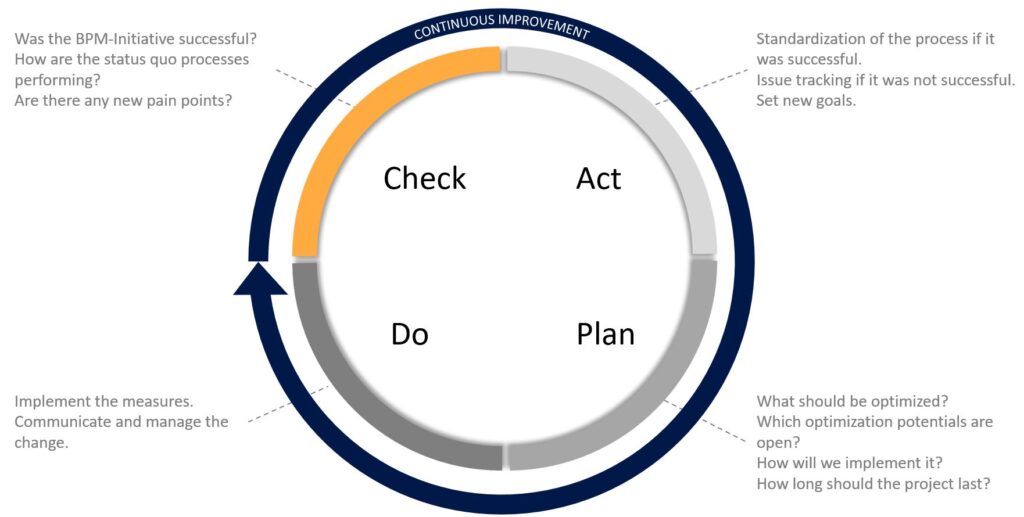Weg vom Abteilungsdenken, hin zum Prozessdenken
Jede Organisation muss sich mit ihren Prozessen auseinandersetzen und sie managen. Dabei sind sie oft den Weg von einem Denken in Abteilungen, hin zum Denken in Prozessen gegangen. Das Ziel ist es, die Effizienz zu erhöhen, die Kosten zu senken oder Ressourcen einzusparen. Um dieses Ziel erfolgreich erreichen zu können, müssen Sie die vier Phasen Prozessidentifizierung, Prozessanalyse, Prozessdesign und den Prozessrollout durchlaufen. Das Ziel dieses Artikels ist es, Ihnen einen Überblick darüber zu geben, wie Sie in Ihrer Organisation Business Prozess Management umsetzen können. Dabei ist die Zielgruppe jeder, der noch vor der Einführung steht, mitten drin ist, nur in Teilen Business Prozess Management betreibt oder diejenigen, die es schon eingeführt haben. Der Einfachheit halber werden wir in diesem Artikel Business Prozess Management mit „BPM” abkürzen.
Start with the goal in mind
Before we get into the four phases, you should be clear with all your stakeholders about your goals. Define what the goal of your BPM initiative is and who should benefit from it. Show your stakeholders transparently what the consequences of the project are for them and what added value they can derive from it. Once you have defined your target picture, you can get started.
Process identification: The beginning of the journey
The process identification phase serves to ascertain and document the processes of the departments that are in scope. This includes documenting the process participants, the process steps, the process results and the previous and subsequent processes. Since the resources needed for such an extensive analysis often have little time, you should relieve them of as much work as possible. Here it is a good idea to build on what has already been created. Be it department-specific user guides, policies, already created process documentation or even training documents. Collect these documents and put them into a uniform format so that they can be used in the discussion. A uniform representation of the processes in a modeling language such as BPMN, EPK or ARIS is recommended. In this way, it is important to check that the processes are up to date in order to identify deviations and to include processes that are completely missing. You have to decide for yourself in which granularity you want to collect the processes. Start with a low granularity to record the processes and then enrich them with more details as required. In addition to the modeled processes, the goal of the process identification phase is a process landscape that shows the sequence and interrelationships between the processes.
Process analysis
After you have identified your processes, you can start analyzing them. The goal of the analysis phase is to identify optimization potential. A distinction is made between qualitative and quantitative analysis methods.
In qualitative analysis, the process is subjectively examined for optimization potential. One possible method is stakeholder analysis, which is also often used in project management. In this process, the stakeholders of the process are asked about optimization potentials. The optimization potentials are maintained in an issue list, prioritized and then taken into account in the process design phase.
Quantitative analysis, on the other hand, takes a more analytical approach. For example, the processes are provided with KPIs and monitored. Based on the information obtained, conclusions can then be drawn about optimization potential.
If you know which process needs to be optimized and what the predominant pain point is, you can assign process owners to the processes.
Definition of responsibilities
Before you optimize the identified processes, you should define process owners who will be responsible for the success and ongoing optimization of the process in the future. The definition of responsibilities is deliberate after the analysis of the processes, since a pain point can also be the process owner who, for example, is not willing to adapt his process. In general, a distinction is made between process owners and process managers.
The process owner is the person in your company who is responsible for the processes in his area. He or she ensures that the processes are aligned with the company's goals, that they comply with the prevailing policies, that they are optimally supported by the IT landscape, and validates whether the process fulfills its purpose or needs to be adapted.
Process managers, on the other hand, are operationally oriented and are responsible for individual processes. They are responsible for ensuring that the process is executed without problems and in accordance with the definition. In addition, he monitors the quality of inputs and outputs and the performance of the process with KPIs. The process manager has an essential role in your process organization, because he ensures that the processes run without problems in the daily business.

For an end-to-end process, such as order-to-cash, there may be multiple process managers for the individual processes, but there should be only one process owner.
Process design
The process design phase is completely dedicated to the revision of the identified process. Since there are countless articles, books, management guides, etc., we would like to focus only on a method that we believe can be most easily adapted. The 7FE method is a BPM framework for BPM projects or programs. The framework can be broken down into four phases: Prepare, Generate, Validate and Future (Realize).

In the Prepare phase, all relevant information is gathered in workshops. This includes how the redesign initiative fits in with the corporate strategy, what the common goal of process optimization is, what constraints there are, and what the planned project duration is.
In the Generate phase, ideas are collected for the later optimization of the process. It is advisable to have a neutral person lead the workshop here, as they are not attached to the current status quo process. The workshop participants should have a deep understanding of the process to be optimized. Ideally, the result of the workshop should be one or more optimized versions of the process. These should then be examined for their feasibility and their closeness to the requirements.
This happens in the validate phase. It is important to test the individual process versions in order to roll out only the best at the end. The first step should be to check whether all requirements have been met. If this is the case, you should seek expert opinions from Compliance, IT and, if necessary, your auditors to check whether the process can be implemented in its current form. Once you have decided on a process version, you can roll it out to your organization.
The Realize Phase or the Future Phase, as it is called in the 7FE Framework, is about the realization of the elaborated process. For this purpose, you should set up a project to carry out the process adjustments in a structured manner and to accompany the change in your organization. One of the most important tasks is to involve the employees who are affected by the change. Many optimization initiatives fail because employees are closed to change because they do not know what is coming. Therefore, we recommend that you actively pursue change management for the success of your BPM initiative. Again, it is recommended to have a neutral person perform the process implementation.
The continuous improvement
Once you have identified your processes, uncovered optimization potentials and implemented them, your continuous improvement can begin. After implementing your optimization potentials, the cycle starts again. Identify weaknesses in your processes, get the right people around the table, define one or more target processes and implement the best one. The trigger for optimizing a process is always the identification of a weak point.

